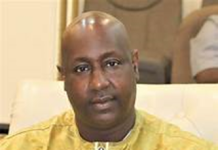By: Aja Musu Bah-Daffeh
The National Disaster Management Agency (NDMA) based on its investigation, reports that 5,406 have been Internally Displaced across the communities affected by the heavy downpours that occurred on 30th and 31st July, 2022.
The Situation Report prepared by NDMA shows that 52.4% of the Internally Displaced Persons (IDP) are females, adding that they need support on protection and related issues. It stated that NDMA and the Red Cross have established a temporal IDP camp in Banjul at St Augustine’s Senior Secondary School which is housing about 350 people mostly women and children.
“The majority of the IDPs are living with relatives. Hundreds of houses have been completely or partially damaged and unsafe for human habitation,” the report stated.
Stating the environmental hazards, the situational report affirmed that, “In many of the affected communities, it is realised that sewage systems and waterways have been blocked as a result of waste disposal in those gutters.”
It continued to state that many houses have been built in waterways thereby affecting its flow, adding that most houses dispose their waste in the rain and that results to blockage of waterways.
In mitigating the health risk that could be caused by water borne diseases, pregnant women and children under 5 have been safely lodged as they are said to be the most vulnerable and hence, need special attention and care.
Furthermore, the report explained that there have been numerous incidents of diarrhea and skin rashes reported in Tobbaco-Road in Banjul over the past few days.
“This is a very high risk of water borne diseases emanating from the flash floods and the slow receding waters,” the situational report elaborated.
In raising concerns on water, hygiene and sanitation, the report shows that 337 water points and 3,623 sanitation facilities have been affected stating that it is a huge concern in the Greater Banjul Area especially Tobacco Road in Banjul, Ebo-Town, Kotu, Manjai and Nemakunku.
“In these and many more communities, water is not receding at all or doing so at a very slow pace. In Tobbaco Road, the sewage system has over flooded and mixed with the flood waters,” it asserted.
Describing the terrible stench emanating from the stagnant waters, it said that the water in Banjul is yellowish green with a pungent smell adding that children and other people are seen playing in these waters or working through to access shops and markets.
The report continued to say “These floods and stagnant waters have also attracted reptiles in some communities posing a risk to the population.”
Notwithstanding, the report clearly states that 40,501 people have been affected across the country by the torrential rain.
In giving the statistics, it established that children under 5 accounts for 22% of the affected population while females account for 51% of the total affected population of which 2446 pregnant and breastfeeding women have been recorded and by extension 1756 persons with disabilities have also been affected.
Background on heavy floods in the Gambia
The July 30th and 31st Flash floods are the worst that have hit the Gambia in nearly half a century. The torrential rain associated with thunderstorms resulted to flash flooding which affected the entire country. According to the Department of Water Resources ‘’rainfall quantity recorded during this period was 276 mm at Banjul International Airport, Yundum.
The country experienced the same on 31st July 1998 with rainfall amount of 175.4 mm recorded. While historical records of floods date as far back as 1948, significant floods experienced in the country were in 1988, 1999, 2002, 2010, 2020 and now 2022. This shows that the frequency of flash floods and climate related shocks are becoming more persistent.
Since the flash floods on July 31st, there have been almost daily heavy downpours in many parts of the country thereby exacerbating the floods in many communities.




















